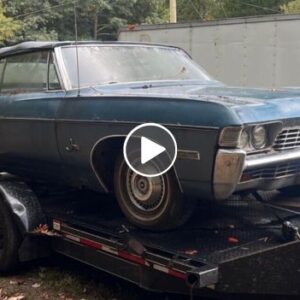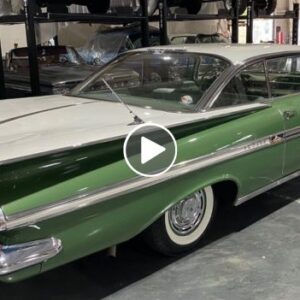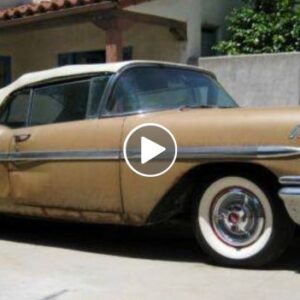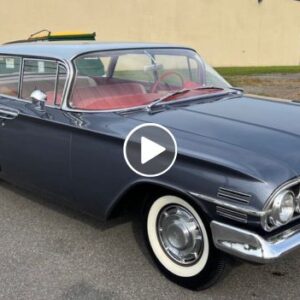
Looking back at the ’70 GTO, many enthusiasts regard it as the last goodyear, the one that still offered high-compression engines and performance uncompromised by government regulation. While that may be accurate in the strictest sense, the truth was that the new-car marketplace became a much more hostile environment for muscle cars, and, as a result, production volume of the GTO and many of its competitors plummeted.
Though the ’70 Muskie Clean Air Act was not passed in time to have a significant impact on model-year-’70 production cars, other factors were coming into play. The most significant of these was backlash from insurance companies on performance cars. Since the beginning of the muscle-car era, the insurance industry had paid out large amounts of money for collisions, personal injuries, and deaths occurring at the hands of drivers of big-engined, high performance vehicles. As a result, America’s insurance companies started slapping large surcharges on high-performance cars. Cars with 10 pounds per horsepower or less, or those with four-speed transmissions were assigned Class 1 status, meaning they would be charged the highest rates possible. Since the GTO was the originator of the muscle-car genre, the insurance companies were paying particular attention to it. At the time, it was not unheard of for a muscle-car insurance monthly premiums to exceed the monthly car payment itself.
There was more bad news. The federal government set its sights on the entire auto industry. The head of the National Highway Safety Bureau (a predecessor of the National Highway Traffic Safety Administration NHTSA), Dr. William Haddon Jr. said, “The way the auto industry is pushing muscle cars borders on criminal irresponsibility.”
Even GM’s upper management was feeling the pressure and trying to distance themselves from the very products they were so aggressively promoting. GM President Ed Cole commented, “Too much attention is being directed toward the youthful segment of our population. This trend is [based on] two false assumptions. One is an overrated opinion of the sales accounted for by the younger set. The second false assumption is that unless you address yourself in the language of the hipgeneration, you’re not in with the entire population.”
With the tide turning so abruptly, it is easy to see why muscle car sales dropped off. People still wanted them, but the pool of buyers who could afford them and the insurance was significantly smaller. Sadly for Pontiac, much of its image was centered around the youth market and performance, and sales of the entire line had fallen by about 38 percent, which cost it the coveted Third-Place position in domestic-auto new sales. With Pontiac’s youth-oriented General Manager John Z. DeLorean’s departure the year before, the Division lost its biggest supporter of performance cars and his absence would be quickly felt.

As was the case in ’69, the ’70 GTO was available as a two-door hardtop and a convertible. While this first of the ’70s GTOs carried over the same platform and inner body structure as the year before, it was treated to extensive restyling. With the exception of the roof and hood, the ’70 GTO was all new sheetmetal.
Up front, a new Endura bumper design was incorporated, loosely resembling the nose of the ’69 Firebird. It was more rounded though, and lacked the chrome insert. The headlamps were now outside the confines of the grille, eliminating the hideaway option, which looked great, but had its problems with long-term functionality. The turn signals used for ’69 were retained, though the cornering lamps were changed to a design similar to the optional cornering lamps used the year before.
The front fenders and rear quarters were redesigned and featured eyebrow contours, a feature that was seen earlier on the ’69 Firebird. The eyebrows ran horizontally the entire length of the front fenders and into the door skins. They then picked up again at the leading edge of the rear quarter and ran all the way to the rear bumper. The rear-bumper and taillamp design wrapped around into the rear quarter panel and eliminated the need for rear-quarter marker lamps.
The ’70 GTO’s freshened look was very successful. It gave the muscle car a more squared-off and aggressive appearance, and today it is regarded by many enthusiasts as one of the cleanest and most attractive designs in all of muscle-car history.
Inside, the GTO was treated to its third instrument-cluster update in three years, with a new 140-mph speedometer and a new wood applique. A new padded Formula steering wheel joined the lineup and revised door panel and sear upholstery were used. The basic interior dimensions and functionality remained from the ’68 (Gen II) redesign.

The majority of the ’70 GTO engine lineup was retained from the previous year, including the base 350hp 400/four-barrel, 366hp 400 Ram Air III, and top dog, 370hp Ram Air IV. The low compression 400/two-barrel was dropped from the lineup.
On the plus side, a new 455ci version of the Pontiac V-8 became available. It was a bored and stroked version of the large-journal 428, with a 4.15-inch bore and a 4.21-inch stroke. Though it was called the 455 H.O., it was essentially the same engine that was offered in the full-size models that year and was not a true high-performance engine, though it was available with Ram Air. It would prove to be the only year the 455 was available as a high-compression engine.
The new 455 produced a respectable 360 hp at 4,600 rpm and a whopping 500 ft-lb of torque at 3,100. This made for a great street engine, especially with the rising curb weights, numerically lower final-drive ratios, and luxury options, such as air conditioning. To help counter the added torque, GTOs ordered with the 455 received the stronger GM 12-bolt rearend. Had Pontiac built a 455 with a Ram Air IV top end and camshaft, it would have been one of the muscle car era’s all-time greats, but the climate did not allow for the business case to be made (warranty fears). Ironically Chevrolet released their powerhouse LS-5 and LS-6 Chevelles that same model year.
The ’70 GTO was the first in the model’s lineage to offer an optional rear sway bar. Though sway bars had been tested in GTOs in previous years and had been available from the start in other GM A-Body cars such as the Olds 442, they were never added to the GTO option sheet, citing diminished ride quality and other negative handling issues. Those issues were finally corrected to the satisfaction of Pontiac’s engineers, so a new 0.875-inch rear bar with matching, boxed rear lower control arms made its debut on the model. The new rear sway bar was used in conjunction with a heavier 1.125-inch front bar. The result of the new handling package was the best-handling GTO up to that time.

A rare and now sought-after option offered for a short time in ’70 was the now-legendary Vacuum Operated Exhaust (V.O.E.) exhaust system. It featured vacuum-controlled internal muffler baffles to alter the sound level of the exhaust system. The system was engaged by a knob under the dash and was not available with Ram Air, meaning that only the base engine and the 455 H.O. were eligible for this option. Factory records indicate that only 233 cars received this option before it was canceled.
A relaxing of tariffs between the U.S. and Canada meant that there was no longer a need for the Beaumont sub-marque, so it was replaced with American-spec Pontiacs, which began selling in Canada. As a result, Pontiac GTOs gained another assembly plant, Oshawa, Ontario. Some Judges were built there, though factory records show that none of them were Ram Air IV cars. If your ’70 GTO has a 1 in the seventh position of its VIN, it is a Canadian-built car.

The Judge returned for ’70, with updates to a complement the new bodywork. The new color Orbit Orange replaced Carousel Red. New tri-color stripes that augmented the eyebrow contour of the fenders were added to the lineup early in the model year, though some cars came through with the ’69 design for striping. A new dual- pedestal, rear-deck wing bowed for ’70. Its design created a bit of down force, as opposed to the lift that the ’69 designs added to the mix. Polar White Judges could have the spoiler painted matte black. Some ’70 Judges also received a chin spoiler, though it’s not clear why.
Like the GTO, Judge production dropped off dramatically, with the year’s tally ending at 3,797 units, of which just 168 were convertibles.
Pontiac was not in an enviable position in ’70, which is somewhat ironic, since ’69 had been its best-selling year. With the sales of muscle cars dropping off and Pontiac having so much of its identity based on performance, it dusted off the Tempest E.T. concept and released a new line of insurance-friendly performance cars midway through the model year.
John Z. DeLorean’s successor, new Pontiac General Manager F. James McDonald, had risen through the ranks on the manufacturing sides of Pontiac and Chevrolet, and was previously Chevrolet’s director of manufacturing. Seeing Pontiac’s recent reversal of fortune, he decided that dropping base prices would stimulate sales. He added a heavily decontented line of A-bodies, known as the T-37. It is from this line of cars that Pontiac released its own Road Runner-beater, the GT-37.
It was a sporty but spartan machine that could be ordered on either the pillared-coupe or hardtop-coupe body style. Its base engine was a 350/two-barrel with a floor-shifted, heavy-duty, three-speed manual transmission. Optional engines included a 400-inch V-8 in two-barrel or four-barrel versions. Two and three-speed automatic transmissions were also available. Standard equipment included a GTO-style dual exhaust with chrome tips, G70-14 raised-white-letter tires, Rally II wheels without trim rings, ’69 Judge-style fender stripes, hoodpins, a 140-mph speedometer, and GT-37 badging. A rear wing was available, but bucket seats were not.
Other performance-oriented options could be had on the GT-37, such as limited-slip differential, heavy-duty frame, and heavy-duty suspension. In a case of bad timing, the 350 H.O. engine was dropped for ’70. It would have been the perfect performance engine for an insurance-conscious performance-car buyer. Production of the ’70 GT-37 stood at 1,419 units.

“The Great One” promotional campaign for the ’67-’69 GTO had run its course. It was replaced by “The Humbler,” which was used in print ads and television commercials. Perhaps the most memorable TV spot promoted the V.O.E system, and it aired during the ’70 Super Bowl. In it, an early ’70 GTO with ’69 stripes is seen slowly cruising through a drive-in restaurant, its young driver confidently wheeling the GTO through the parking lot, making sure everyone sees and hears the new Goat with its mufflers in the loudposition. At the end, the announcer says, “The Humbler is here. This is the way it’s going to be, baby.”
The Humbler campaign was used in several versions, one being a three-page foldout with a Cardinal Red GTO coupe. (It appeared in the Oct. ’69 issue of Hot Rod.) Another ad showed six young boys, three to a side, leaning on a Cardinal Red GTO with the tagline, “The Quick Way out of the Minor Leagues.” It was clear, though, that the era of aggressive, youth- oriented advertising had come to a close. Even this watered-down ad created outrage from safety groups in and out of the federal government.
In a reversal of long-standing policy, Pontiac Chief Engineer Steve Malone cancelled the Royal Pontiac-prepped Pontiac test-car fleet. The pool of magazine tests dropped off dramatically. The absence of Bobcatted ringers meant the big performance numbers needed to sell GTOs were not appearing in magazines, and the articles that were published featured stock, showroom cars. The reality was that real-world performance numbers hadn’t changed much for ’70, though the perception was that they certainly had.
A good case in point was Car and Driver’s test of a loaded ’70 455 GTO four-speed with an open 3.31 rearend. Outfitted with air conditioning, and power windows and door locks, it was certainly not something that would have come out of the Royal Pontiac test-car pool. With a very hefty 4,209-pound curb weight, the GTO clicked off a 0-60 in 6.6 seconds and covered the quarter-mile in 15.0 seconds at 96.5 mph. Considering the mild gear and porky test weight, it was a respectable performance for what it was—but not compared to the competition.
Faring a bit better, Car Life did a side-by-side test of two GTOs: a Ram Air III 400/four-speed with 3.90 gears, along with another loaded 455-powered GTO. This one was an automatic with Ram Air and a 3.55 gear with Safe-T-Track. The 4,230-pound Ram Air III ran 0-60 mph in 6 seconds flat, with a quarter-mile time of 14.60 at 99.55 mph. The 455 ran a 6.6-second 0-60 and posted a 14.76 at 95.94 mph with a massive 4,455-pound test weight.
Road Test magazine tested a Ram Air III 400/four-speed Judge with 3.55 Safe-T-Track and a more reasonable 3,780-pound test weight. It ran a 14.77 e.t. at 94.42 mph.
As mentioned, production numbers for the ’70 GTO dropped significantly from the previous year, less than 42 percent of the peak year of ’66. The year ended with 40,149 units out the door—3,784 convertibles and the 3,797 Judges.
As time progressed, the GTO found itself facing more hurdles, more regulation, and fewer buyers. The entire muscle-car segment was finding itself forced out of fashion, and things would continue to get worse.
The 4,230-pound Ram Air III ran 0-60 mph in 6 seconds flat, with a quarter-mile time of 14.60 at 99.55 mph






